|
FIGURE
2.1 The Nervous System
The nervous system includes the brain, spinal cord, and the peripheral nerves that carry messages to and from all parts of the body. |
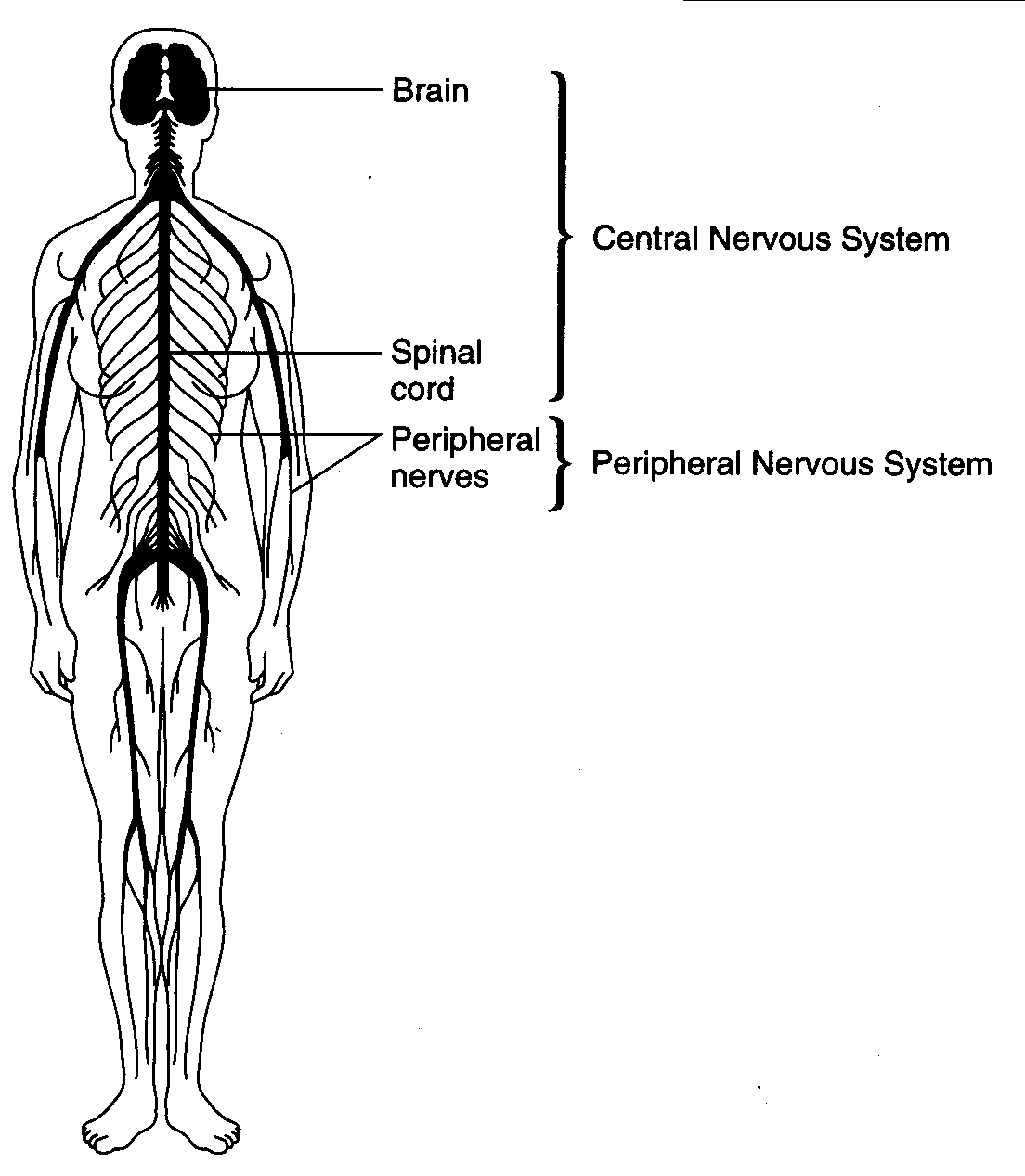 |
| chapter 2 |
Most members of the animal kingdom have three primary goals. The first is to find enough to eat. The second is to avoid becoming someone else's dinner. The third is to reproduce. To most animals, stress is a simple phenomenon. It usually wears the face of a predator or another animal competing for a mate or food source. Environmental conditions create stress as well: people, floods, and drought, for example, affect availability of nesting sites and food supplies.
Only a short while ago in geological time, our primitive ancestors were challenged by similar sources of stress. Nature favors survival of the fittest. Cavemen and women who were best able to escape predators, deal with disaster, and obtain food and mates were those who produced future generations who eventually produced us.
As you will learn in this chapter, the stress response produces physical changes that improve an organism's ability to cope with physical threats. It increases our strength and helps us run faster and farther. A strong stress response probably provided an evolutionary advantage for our prehistoric ancestors. The stronger their stress response, the better able they were to fight or flee predators, endure long journeys in search of food, and protect and provide for their children.
Civilization has changed, and the routine challenges we face rarely require a strong physical response; but human physiology is not so different from that of our ancient ancestors, and we still respond to perceived threats with the same fight-or-flight arousal. Such arousal is still quite beneficial when we must confront an attacker, rescue a child in danger, or even sprint to catch a bus. But what about the stress of feeling overloaded with work? Being consistently awakened by a noisy neighbor? Having to work with a difficult professor? By and large, your stress response is inappropriate for the challenges you face, as you rarely have an opportunity to fight or run away. This is the heart of the problem. A response that is sometimes advantageous is more often inappropriate and may ultimately cause physical strain and disease. Understanding the fight-or- flight response will enable you to better understand the health effects of chronic stress and the importance of stress management.
Students, especially those with little background in biology, have reported that this chapter causes more stress than any other chapter. Expecting this text to relieve rather than create stress, many are initially taken aback when faced with the intricacies of stress physiology. Read slowly, take notes, and then reread the chapter once again. Don't memorize anything you don't have to, but look for common themes and real life applications.
FIGHT OR FLIGHT?
Imagine you are walking along humming your favorite song to yourself when suddenly you hear a threatening growl behind some bushes. The growl turns into angry snarling, and a raging pit bull terrier emerges from the shrubbery, dragging a broken chain. Teeth bared, he rushes toward you in a frenzy. Fortunately for you, your immediate appraisal of this threat activates your fight- or-flight response and all systems are go, either to counter the attack or beat a hasty retreat.
Some of the manifestations of the fight-or-flight response are quite obvious: a rapidly pounding heart, shallow breathing, increased sweating, muscle tension, dry mouth, and stomach butterflies. Let's take a closer look at the stress response to see how these symptoms are produced and how they help you deal with that snarling pit bull.
The fight-or-flight response is orchestrated by your brain, which activates various organs such as your muscles by sending messages of arousal. These messages are sent in two ways. The first and fastest is by the nervous system, which activates the fight-or-flight response through direct communication with target organs via the nerve cells. The second is the endocrine system, which activates the fight-or- response through the action of chemical messengers called hormones that reach target organs through the circulatory system. Let's start with the nervous system to see how the fight-or-flight response is produced.
THE NERVOUS SYSTEM
The nervous system consists of your brain, spinal cord, and the peripheral nerves that travel from your spinal cord to all parts of the body. The brain and spinal cord make up the central nervous system (CNS) while all other nerves are considered the peripheral nervous system (see Figure 2.1). It is the job of the nervous system to coordinate all parts of the body so that they work together. The afferent nervous system consists of the nerve cells that receive information from the external and internal (inside your body) environment and conduct this information to the brain, where it is processed at both conscious and subconscious levels. In the example above, your ears send information about the dog growling, your eyes send information about the dog's movement, internal sensors (proprioceptors) send information about your body's position and muscle tension. Your brain integrates all this information, recalls past experiences and everything your mother ever told you about strange dogs, and decides what to do. Run as fast as you can! So the brain sounds the alarm and sends messages to all systems of the body via the efferent nervous system.
The efferent system is subdivided into two parts. The somatic nervous system sends impulses from the central nervous system to skeletal muscles. This is how the body produces movement. This system is considered to be at least partly under conscious control. You've decided to flee rather than fight the dog; your brain coordinates muscular contraction to produce a personal best in running time. The autonomic nervous system (ANS) sends information from the central nervous system to nonskeletal systems such as the circulatory system (heart and blood vessels), respiratory system (lungs and airways), digestive system (stomach, pancreas, liver, gallbladder, small intestine, large intestine), urinary system (kidneys, bladder), and endocrine system (glands). Scientists generally regard the activity of the ANS as outside voluntary control, although biofeedback research has shown people can learn to control many autonomic functions, including heart rate, stomach acidity, and blood pressure.
|
FIGURE
2.1 The Nervous System
The nervous system includes the brain, spinal cord, and the peripheral nerves that carry messages to and from all parts of the body. |
 |
The autonomic nervous system can either speed up or slow down the activity of the organs
and systems it innervates. The two branches of the ANS that perform these functions are the
sympathetic nervous system (SNS) and the parasympathetic nervous system (PNS) (see Figure
2.2). In the fight-or-flight response, your brain activates the sympathetic nervous system, which
speeds up those functions necessary for immediate survival. For example, the liver releases sugar
into the bloodstream to fuel the working muscles, the heart beats faster and harder to circulate
plenty of blood. The SNS suppresses such functions as digestion, which can be postponed.
Following are some of the important physiological effects of the SNS response that help us fight
or flee:
| Sympathetic nervous system response | How it helps us fight or flee |
|
Increases heart rate Increases contractile force of the heart (heart beats harder) Dilates (opens) coronary (heart) arteries Dilates arteries to active muscles Constricts arteries to skin and abdominal organs
Dilates pupils Relaxes ciliary muscle of the eye
Dilates bronchioles (airways)
Releases glucose (sugar) from liver; releases fats from adipose (fat) tissue |
Increases blood flow to active muscles, lungs, and heart. Blood carries oxygen and nutrients needed by working muscles and removes the waste products generated by muscle metabolism. Reduces nonessential circulation.
Improves vision
Improves distance vision
Increases flow of air to lungs
Provides more fuel for working muscles |
After getting safely away from the dog, you heave a sigh of relief and collapse into a chair. At this point, your brain decreases SNS activity while increasing parasympathetic output. This is the relaxation response. Heart rate and blood pressure return to normal, muscles relax, and your stomach and intestines resume the task of digesting your lunch. Some of the actions of the sympathetic and parasympathetic branches of the autonomic nervous system are listed in Table 2.1. In this table you can see that the actions of the sympathetic nervous system are balanced by the actions of the parasympathetic nervous system. For example, activation of sympathetic nerves causes the heart rate to increase, while activation of parasympathetic nerves causes the heart rate to decrease.
BRAIN PHYSIOLOGY: THE BODY/MIND CONNECTION
Let's go back to one of the most important components of the nervous system: the brain (see
Figure 2.3). As we examine how the brain participates in the stress response, you'll see why it's
impossible to separate completely the psychological and physical responses to stress. This
interaction forms the basis for an area of study known as psychophysiology. Psychophysiology
is the study of the relationship between psychological and physiological functions; it provides
much of the basic information we have concerning the physiology of stress.
The most obvious role played by the brain in the stress response is as the seat of conscious
thought and awareness. Here is where you evaluate demands placed on you and your ability to
respond. Here is where purely imaginary ideas and fears can trigger a full-blown stress response.
Thought, judgment, and memory of past experiences occur in the outer layer of the brain, the cerebral cortex, which is the largest area of the
brain. Sensory areas in the cerebral cortex interpret sensory nerve impulses, motor areas control
movement, and association areas are involved with emotional and intellectual processes.
FIGURE 2.3
The Brain
The brain coordinates the nervous and endocrine responses to stress.
Deeper areas of the brain participate in the stress response as well. An area called the
diencephalon is made up of the thalamus and hypothalamus. The thalamus integrates and relays
sensory information to the cerebral cortex. It helps interpret sensations of pain, temperature, and
pressure; it is also involved in emotion and memory. The hypothalamus is an important control
center for many physiological functions. It controls the autonomic nervous system, regulates the
pituitary gland, and secretes several hormones and other chemical factors. The hypothalamus
appears to be the center for the learned control of autonomic functions that occurs during
relaxation and biofeedback training.
The thalamus and hypothalamus are part of an area of the brain called the limbic system,
which also includes part of the cerebral cortex and other structures. It lies above and around the
brain stem and is involved with motivation and emotion; it also contributes to memory. Because
of its function in emotions such as pain, pleasure, anger, fear, sorrow, sexual feelings, and
affection, the limbic system is sometimes refered to as the "emotional" brain (Tortora &
Grabowski, 1993).
The deepest area of the brain is the brain stem. This is the "oldest" part of the brain, having
been around for the longest period of our evolution. The brain stem contains structures that
automatically regulate essential life functions such as
breathing, heart action, and digestion through the sympathetic and parasympathetic branches of
the autonomic nervous system. Although these functions are considered involuntary,
psychological factors such as stress can affect them. An example is anxiety hyperventilation, in
which breathing becomes very fast and interferes with the normal regulation of
blood gas
(oxygen and carbon dioxide) concentrations, resulting in dizziness, shortness of breath,
pounding heart, and even fainting. Anxiety hyperventilation is uncomfortable and even
frightening, and many experiencing this condition interpret it as an impending heart attack. Some
research has suggested that breathing practice and relaxation are effective treatments for
hyperventilation (Hegel et al., 1989). Rebreathing air in and out of a paper bag also works (by
raising the carbon dioxide content of inspired air).
The nerve fibers of the reticular formation (RF) run through the middle of the brain stem up
into the diencephalon and act as a major communication pathway between the brain and the rest
of the body, an important body-mind connection. The RF scans the sensory information making
its way to the brain and evaluates its importance. It alerts higher centers to critical information,
thus stimulating arousal and consciousness.
The reticular formation selectively relays sensory information upward for further processing,
sending on information deemed relevant and short-circuiting sensory information that seems
unnecessary. This limits the amount of sensory information that actually reaches higher levels of
the brain and keeps us from being overwhelmed with input. How does the RF "know" what is
important? It receives information from higher brain centers responsible for emotion, motivation,
and other associative processes that helps it "decide" what is relevant. For example, you may fall
asleep while waiting for a friend to stop by. You snooze on, oblivious of the noise of traffic
outside and the radio playing, but you awaken when you hear a knock on the door. The RF
signals you that an important message is coming through. In our pit bull example, the dog's angry
snarl need not be loud to be noticed above background noise such as traffic and construction.
The RF knows this sound requires your attention.
An interesting application of this selectivity function of the RF is relaxation training for the
treatment of chronic pain. The RF functions with the thalamus to control awareness of pain.
Negative emotions associated with pain may increase sensory transmission of pain by the RF
and thalamus, while relaxation training may
help reduce the transmission of pain impulses, thus reducing conscious awareness of pain.
Childbirth is a good example. Feeling fearful and out of control increases a woman's pain during
labor. Breathing and relaxation exercises accompanied by reassuring, supportive labor coaches
help reduce fear and sensations of pain. Less medication is called for in these cases and labor is
generally easier (Rosen, 1991).
The brain governs and coordinates the autonomic nervous system and endocrine system.
Let's take a look at how the endocrine system complements the action of the ANS in the
production of the fight-or-flight response.
THE ENDOCRINE SYSTEM: RAGING HORMONES
Raging hormones. Where do they come from? Hormones are chemical messengers produced by
the endocrine system that, along with the nervous system, coordinates physiological functions
so that all parts of the body work together. Messages from the nervous system reach specific
sets of cells via nerve cell networks and take only milliseconds to transmit. The instantaneous
response of the autonomic nervous system is why the fight-or-flight response occurs so quickly.
The endocrine system releases hormones into the bloodstream, from where they reach and can
affect virtually every cell in the body. Messages from the endocrine system may take from a few
seconds to several hours or more to bring about their specific effects.
Why two systems? Many physiological responses, such as the fight-or-flight response, are
so essential to survival that back-up systems have evolved. The immediate response of the
sympathetic nervous system is backed up by the longer lasting action of several hormonal
pathways, as you will see in this section. As you read about the actions of these hormones, you
might anticipate why long-lasting stress, and long-term activation of these hormonal pathways,
can lead to negative health effects.
The nervous and endocrine systems work closely together and are linked in several ways.
The nervous system can stimulate or inhibit the release of hormones, while hormones can
stimulate or inhibit the transmission of nerve impulses. Hormones have many functions, including
the regulation of metabolism, reproduction, and growth and development (Mills & Chir, 1985).
Let's take a look now at how they help us respond to stress.
Your brain has been alerted to the rapid approach of the snarling pit bull terrier. This
message came from sensory information relayed by your eyes and ears up
through the reticular formation (no chance of this information getting short-circuited!) and to the
cerebral cortex. The information has been processed with input from the limbic system, and a
message has been sent to the hypothalamus to sound the alarm. The hypothalamus immediately
initiates sympathetic nervous system arousal and the fight-or-flight response has begun. An
endocrine response is initiated as well. Here are some of the pathways involved.
What a Rush: Hormones of the Adrenal Medulla
When responding to stress, the autonomic nervous system stimulates the adrenal glands, which
sit on top of the kidneys like little caps (see Figure 2.4). The adrenal glands are really two glands
in one. The outside layer is called the adrenal cortex while the inner portion is the adrenal
medulla. The adrenal medulla is activated by direct nerve connection with the posterior (back
portion) hypothalamus, and when stimulated secretes the hormones epinephrine (commonly
called adrenaline) and norepinephrine (also called noradrenaline). These hormones are
collectively referred to as the catecholamines; they are sympathomimetic-that
is, they have
effects similar to those listed for the sympathetic nervous system, as shown in the following list
(Mullen et al., 1993; Tortora & Grabowski, 1993; Woods, 1987):
Increase the heart rate and contractile force of the heart, thus also increasing blood
pressure.
This increases blood flow to active muscles, heart, and lungs.
Dilate arteries
in the heart, lungs, brain, and skeletal muscles.
This increases blood flow to organs
essential for fighting or fleeing.
Constrict peripheral arteries (arteries in hands and feet).
This ensures good blood
flow to the heart and is why, under stress, you get "cold feet." Hand temperature may
also decrease. Dilate airways.
Increases air flow to lungs. Increase blood sugar level.
This is accomplished by signaling the liver to release
stored sugar into the blood, which supplies more fuel for working muscles. Increase metabolic rate (speed up cellular metabolism).
This speeds up energy
production to support emergency functions. Slow digestive processes.
This spares energy for essential fight-or-flight
processes and avoids wasting energy on unnecessary functions. Contract spleen.
This releases stored blood, which increases blood volume Red blood
cell production also increases.
Speed rate of clotting.
This prevents bleeding.
Increase sweating.
The adrenal glands are
composed of the adrenal medulla and the adrenal cortex; they
are located on top of the kidneys.
Even as it is orchestrating the autonomic nervous system response to stress and stimulating the
response of the adrenal glands, the hypothalamus is secreting some hormones of its own. The
anterior (front portion) hypothalamus secretes a hormone called corticotropin-releasing
hormone (CRH) which stimulates the pituitary gland, located at the base of the brain, to release
adrenocorticotropic hormone (ACTH). ACTH is carried in the blood stream, and soon reaches
the adrenal glands. ACTH acts on the adrenal cortex, stimulating it to release two families of
hormones called glucocorticoids and mineralocorticoids (see Figure
2.5). This sequence is
known as the hypothalamus-pituitary-adrenal pathway.
Cortisol
(hydrocortisone), corticosterone, and cortisone are three glucocorticoids involved
with the-fight-or-flight response. Glucocorticoids affect several metabolic processes. Cortisol is
the most abundant glucocorticoid and is responsible for about 95 percent of glucocorticoid
activity (Tortora & Grabowski, 1993). Glucocorticoids do the following (Chrousos & Gold, 1992;
Tortora & Grabowski, 1993):
Mobilize energy sources by increasing the rate of protein breakdown in cells,
especially muscles, so that the proteins may be used for energy or to make enzymes.
The glucocorticoids stimulate the liver to produce glucose from certain protein
components if blood sugar is low.
Make blood vessels more sensitive to agents promoting constriction, thus helping to
raise blood pressure.
Since blood loss was often involved in fight or flight for our
ancient ancestors, increased blood pressure was advantageous in maintaining
adequate circulation despite a drop in blood volume.
Glucocorticoids inhibit the process of inflammation.
Inflammation may make the
inflamed area stiff. Preventing mobility limitations is helpful in the short run, but long-
term effects include delayed healing.
Cortisol also causes a decrease in the number of lymphocytes released from the
thymus gland, located in the upper chest, and the lymph nodes. Lymphocytes are an
important component of the immune system defense against bacteria and
other foreign invaders. This decrease in immune activity may be one of the "
energy
conservation" processes of the glucocorticoids. When facing the pit bull, you are not
so worried about the cold germs in your nose. Of course, if you are under chronic
stress and cortisol levels remain elevated, the negative impact of cortisol on the
immune system becomes very important.
FIGURE
2.5 The Hypothalamus-Pituitary-Adrenal
Pathway
Nervous Energy: Thyroid Hormones
There's more. The busy hypothalamus also instructs the thyroid gland in its work. The thyroid
gland is located in the throat (see Figure 2.6). It produces hormones that help regulate energy
expenditure, growth and development, and nervous system activity. Here's how it works. The
hypothalamus secretes thyrotropin-releasing hormone (TRH), which causes the pituitary gland
to release thyroid-stimulating hormone (TSH). This hormone, TSH, then tells the thyroid gland
to secrete the hormones thyroxine (T4) and triiodothyronine (T3), which are functionally similar
and are commonly referred to as thyroid hormones (see Figure 2.7). This sequence of events is
known as the hypothalamus-pituitary-thyroid pathway.
Glands are organs that secrete hormones. The
glands illustrated here play important roles in the fight-or-
flight response.
During the stress response, the thyroid hormones stimulate the breakdown of glycogen and
fats in most cells of the body to increase production of sugar and fats to fuel metabolism. The
thyroid hormones also stimulate protein synthesis. They increase the reactivity of the nervous
system, heightening the autonomic nervous system stress response. Specific actions are
(Greenberg, 1990; Tortora & Grabowski, 1993):
Increase resting metabolic rate. Increase free fatty acids (FFA).
These are produced from storage fat molecules called
triglycerides. FFA can be used as fuel for energy production. Increase rate at which liver converts Protein into blood sugar (glucose).
Increase heart rate and contractile force.
Increase blood pressure and blood flow.
Increase rate and depth of breathing.
Increase gastrointestinal motility (may result in diarrhea).
Increase nervousness and alertness.
Under Pressure: Antidiuretic Hormone
One final hormone important in the stress response and its health effects is antidiuretic hormone
(ADH), also called vasopressin, which is secreted by the pituitary gland. An antidiuretic is
anything that prevents urine production and water loss. This hormone, ADH, causes the kidneys
to remove water from fluid destined to become urine and return it to the bloodstream-an action
that increases blood volume and thus raises blood pressure. Antidiuretic hormone raises blood
pressure by another mechanism as well: contraction of the smooth muscles in the artery walls.
Many things influence the action of ADH. For example, alcohol inhibits ADH secretion and thus
increases water loss. This helps explain why thirst accompanies a hangover.
Summary: Nervous and Endocrine Systems
Is this chapter starting to sound a little repetitious? It should be. At this point you are probably
recognizing some common themes. Both the nervous and endocrine systems mobilize a person to
respond to a stressor in some physically active manner. The hypothalamus activates the
sympathetic nervous system response; it also stimulates the adrenal and thyroid glands through
either direct innervation or stimulation of the pituitary gland to secrete epinephrine,
norepinephrine, cortisol, aldosterone, and the thyroid hormones (see Figure 2.8). Sympathetic
nervous system activation and the endocrine response have similar effects that reinforce each
other. The combined actions of these systems increase metabolic rate and mobilize fuel for
energy production; increase blood pressure, blood flow, and respiration; and inhibit systems not
essential for immediate survival.
Hans Selye: Stress -A Response
Probably best known of the early stress research pioneers is Hans Selye. Selye's
work on laboratory animals in the 1930s and 1940s was some of the first to study
the physical stress response (Selye, 1936). His research described in detail the
stress response of the pituitary and adrenal glands, and the shortand long-term
physical effects of stress throughout the body.
Selye created the first working definition of stress,
describing it as the nonspecific
response of the body to any demand made upon it (Selye, 1956). He
called the response nonspecific because he observed the same physical response
to a wide variety of "alarming agents" including bacterial infection,
trauma, heat, cold, and psychological stimuli (Feuerstein et al., 1986). Selye
believed that in humans, positive stressors, which he
termed eustress-such as getting admitted to college, winning a
scholarship, or taking a trip- caused a physiological fight-or-flight response
similar to that caused by more disturbing change, which he called distress-such
as getting a bad grade in a course, having an argument, or losing your wallet.
He also noted that the same response occurred whether the threat was real or
imagined (Selye, 1982).
Selye devised a theory about the health effects of chronic stress which he
called the
General Adaptation Syndrome (GAS). When exposed to chronic stress, such
as continuous exposure to loud noise, an animal exhibits three stages of
adaptation. Initially, the fight-or-flight response occurs, which Selye called
the alarm reaction. Physiologists link the alarm reaction to the
autonomic nervous system's immediate response to stress (Tortora &
Grabowski, 1993). As exposure to the stressor continues, the animal will develop
some resistance to the stressor. Selye referred to this period as the stage of resistance.
Physiologists have characterized this stage as being supported by the
various stress hormones that circulate throughout the period of stress,
sustaining a long-term stress reaction. The stage of resistance continues until
the stressor stops or the animal's resistance is worn down. At this time it
enters the stage of exhaustion, which, if the stressor continues, ends
ultimately in the animal's death (Selye, 1982).
Selye's approach was typical of scientists working with laboratory animals in
that its focus was on physiological response. Such a focus was convenient
because it defined stress clearly and in a way that could be directly observed
and measured in the laboratory. This early research laid the groundwork for the
expanded definitions of stress to follow.
Selye continued to research and write about stress throughout his life. He
theorized that each person possesses a finite amount of "adaptation
energy," which he compared to "an inherited bank account from which we
can make withdrawals but to which we apparently cannot make deposits"
(Selye, 1982, p. 10). To Selye, eustress and distress both resulted in some
degree of wear and tear, which accumulated to produce aging.
Stress researchers today have a deep respect for Selye's groundbreaking work,
much of which continues to be supported by scientific investigation. Subsequent
research has shown, however, that our responses to eustress and distress do
differ somewhat, as do their health consequences. Psychologists also believe we
probably can make deposits into our "inherited bank account" of
adaptation energy, and this is what increasing one's stress resistance is all
about. In modified form, however, Selye's adaptation energy theory holds much
truth. We have all felt our adaptation energy run low when faced with excessive
stress, and current research supports the notion that too much change increases
one's likelihood of developing stress-related illnesses (Holmes & Rahe,
1967).
FIGHT OR FLIGHT: THE
CARDIOVASCULAR SYSTEM RESPONDS Now
that you understand how the fight-or-flight response comes about, let's take a
closer look at its effects. As you prepare to run away from that vicious pit
bull terrier, your pounding heart signals that the cardiovascular system is
ready far action.
The cardiovascular system includes the heart, blood vessels, and blood. This
system circulates blood to every cell in the body, delivering oxygen, fuel, and
hormones, and removing waste products. Physical activity dramatically increases
the need for these services, which is why the cardiovascular system responds so
strongly to stress. Sympathetic
stimulation causes an immediate increase in heart rate that is reinforced by the
epinephrine and norepinephrine released into the bloodstream by the adrenal
medulla. This response helps you retreat from the snarling dog but can be a
distraction for stress that does not require a strong physical response. Perhaps
you have felt your heart pound when called on in class, before giving a
presentation, or when excited about a phone call. After a while, you relax, your
heart calms down, and no harm is done. But in cases of extreme fright or for
someone with an unhealthy heart, an overdose of catecholamines can be damaging
and even fatal. The heart rate can become irregular and interfere with effective
circulation; coronary arteries may spasm, cutting off blood flow to the heart
muscle (Monagan, 1986; Turkkan et al., 1982). A catecholamine overdose may be
responsible for heart attacks caused by cocaine, which stimulates the sympathetic nervous system (Gawin,
1991; Isner et al., 1986).
Another major effect of the nervous and endocrine systems' stress response on the
cardiovascular system is an increase in blood pressure. High resting blood pressure is called
hypertension, and is caused by many factors, including too much stress. Blood pressure is a
measure of the force exerted by the blood against the blood vessel walls. It can be measured
using a blood pressure cuff (called a sphygmomanometer) and stethoscope, and is typically
measured in the arteries of the upper arm. The pressure of the blood against the arterial walls is
greatest at the moment blood is ejected from the heart as it contracts. This pressure is called the
systolic blood pressure. The diastolic blood pressure is the pressure in the arteries while the
heart is "resting" between beats. Pressure is measured in units called millimeters of mercury
(mmHg), referring to the distance a column of mercury rises in a tube for a given pressure: the
greater the pressure, the higher the column will rise. It is written as systolic/ diastolic. Normal
resting blood pressure varies from person to person but is usually about 120/80 for men and
110/70 for women.
During exercise, systolic blood pressure rises quickly as the amount of blood pumped by the
heart increases. This is a healthy response and ensures an adequate blood supply to the working
muscles. Blood pressure returns to normal after exercise. During the stress response, both
systolic and diastolic blood pressures tend to rise. Diastolic pressure increases with the
increased blood volume and increased peripheral resistance that results from the stress response.
More fluid ejected with
greater force in a smaller system means more pressure. (During exercise peripheral resistance
decreases as peripheral arteries dilate to increase blood flow to the skin for cooling.)
The increase in blood pressure that occurs during the stress response does not appear to be
harmful in healthy people. In fact, as you run from the pit bull terrier, it is quite helpful! You have
a good supply of blood to your brain and muscles. The problem with blood pressure elevation
during stress comes when you don't really need to respond physically to the stressor at hand,
which is most of the time. When excess stress becomes a chronic situation, the nervous and
endocrine stimulation may cause blood pressure to become chronically elevated if that stress
response is not balanced with a healthy dose of the relaxation response (Benson, 1977).
THE SKELETAL MUSCLES: READY TO SPRING
The next time you watch a movie, monitor your level of muscle tension. You may find that high-
energy scenes lead to a sympathetic response. As the protagonist breathlessly pursues the
villain, you may brace for action as well. A loud noise and you jump!
Muscles are collections of muscle cells that are capable of contraction and relaxation. A
muscle's strength of contraction is controlled by the number and type of cells that are activated,
or recruited, by the nervous system. A stronger contraction is produced if more cells are
recruited. Muscular contraction may or may not produce movement. Even resting muscles
maintain some level of contraction. Your skeletal muscles are important actors in the fight-or-
flight response. Their contraction creates the movement that enables you to fight or flee. As you
prepare to respond to stress, your muscles contract in preparation for movement, much like a cat
preparing to pounce. As the pit bull terrier lunges madly toward you, you might initially freeze as
every muscle contracts before you spring into action.
As you relax after a successful escape from the pit bull's jaws, your muscles relax as well.
But imagine an individual under chronic stress, and a muscle group that
remains chronically contracted as it continually braces for action, unable to let go. This is the
beginning of the muscle tension problems that commonly occur in the jaw, neck, shoulder, and
back as posture muscles prepare you to face the worst. Muscle tension creates pain that creates
stress and more muscle tension. Pain from muscle tension may be the result of a partially
contracted muscle cutting off blood flow, leading to oxygen deprivation and a buildup of waste
products in the muscle tissue. Pain may also be caused by muscle spasms that put abnormal
pressure on sensitive joint areas, or lead to muscle tears from inflexibility (Girdano et al., 1997).
CORY'S FIGHT-OR-FLIGHT RESPONSE
As Cory slugged his way through the stress physiology chapter of his stress management
text, he could feel his neck and shoulders getting tighter and tighter. The tongue-twisting
terminology was so foreign, and the effects of the stress hormones all sounded alike. "I
hope the professor doesn't expect us to memorize all this!" he muttered aloud. An
imaginary exam question began to take shape in his mind: "Describe in detail the
physiology of the stress response. List the action of each hormone. Points deducted for
incorrect spelling." Even though the stressor was imaginary, he could feel his breathing
become shallower, and the tension in his neck and shoulders became painful.
As he read the section on muscle bracing, he recognized his symptoms immediately.
"That's me," he thought. "Ready to respond at the least provocation." He could see
himself hunched over like a boxer approaching his opponent, ready to throw a punch. Cory
wondered whether he could change his muscle-bracing response to stress and decided to
make it the focus of his work in the stress management course.
THE DIGESTIVE SYSTEM: PUT ON HOLD
Have you ever given a presentation and had a hard time talking because your mouth was very
dry? Did you ever get into an argument during a meal and suddenly lose your appetite or
develop a stomachache? Have you ever been unable to eat for a week because you had just
fallen in love? These symptoms are a function of the effects the stress response has on the
digestive system (see Figure 2.9).
The digestive system is responsible for converting food into molecules that can be used by
the body. Food is ingested through the mouth, where it begins to be broken down by chewing
and saliva. It is swallowed into the esophagus, which transports it into the stomach. There is a
tight band of muscle called a sphincter (in this case it's called the lower esophageal sphincter)
between the esophagus and the stomach that relaxes during swallowing but then prevents
stomach contents from backing up into the esophagus. Heartburn occurs when this sphincter
relaxes and allows the acidic contents of the stomach to enter the esophagus and produce a
burning sensation.
FIGURE 2.9
Major organs of the digestive system
FIGHT OR FLIGHT? OR SIT AND STEW?
YOUR EXPERIENCE WITH THE FIGHT-OR-FLIGHT RESPONSE
We have presented a rather generic version of the fight-or-flight response, simplified for
easier learning, but of course the stress response manifests itself differently from person to
person. It varies with the intensity and duration of the stressor. It may vary somewhat with
fitness level (Sothman et al., 1991). And some studies suggest that there may be small
differences between men and women, with men experiencing more deleterious
cardiovascular responses (Johansson et al., 1989; Stoney et al., 1988). Most of all, it varies
with one's degree of stress resistance (Dienstbier, 1991).
Take a moment to think about your own stress response. We have noted
that the fight-or-flight response is very useful for situations requiring a physical response.
This arousal is often helpful for mental activity as well. It sharpens the mind and is useful
for giving good performances, writing inspired exams and papers, and energizing important
conversations. It does not appear to be harmful as long as it is balanced by the relaxation
response. But what about those days when you, feel continually wound up, with one thing
after another going wrong? Maybe at the end of one of those days you have gone to bed
but been unable to sleep because your muscles were still tense and your heart was still
beating more quickly than usual.
Try to recall one or two recent occasions when you remember the fight-or-flight
response as inappropriate and obstructive. It could be something as simple as the alarm
going off in the morning. Try to remember your physical response to those sources of
stress. For each source of stress, try to answer the following questions:
What was the source of stress?
What were your physical symptoms?
How long did they last?
What did you finally do to relax?
SUMMARY
Benson, H. Systemic hypertension and the relaxation response.
New
England Journal of Medicine 296:
1152-1156, 1977.
Chrousos, GP, and PW Gold. The concepts of stress and stress system disorders: Overview of physical
and behavioral homeostasis. Journal of the American Medical Association 267: 1244-1252,1992.
Dienstbier, RA. Behavioral correlates of sympathoadrenal reactivity: The toughness model.
Medicine and Science in Sports and Exercise 23: 846-852, 199 1.
Feuerstein, M, EE Labbe, and AR Kuczmierczyk. Health Psychology: A Psychobiological Perspective.
New York: Plenum Press, 1986.
Gawin, GH. Cocaine addiction: Psychology and neurophysiology. Science 251: 1580-1586, 1991,
Girdano, DA, GS Everly, Jr., and DE Dusek. Controlling Stress and Tension. Englewood Cliffs, NJ:
Prentice Hall, 1997.
Greenberg, JS. Comprehensive Stress Management. Dubuque, IA: Wm C Brown, 1996.
Hegel, MT, GG Abel, M Etscheidt, S Cohen-Cole, and Cl Wilmer. Behavioral treatment of angina-like
chest pain in patients with hyperventilation syndrome. Journal of Behavior Therapy and
Experimental Psychiatry 20: 31-39, 1989.
Holmes, TH, and RH Rabe. The social readjustment rating scale. Journal of Psychosomatic Research 11:
213-218, 1967.
Isner, JM, NAM Estes 111, PD Thompson, et al. Acute cardiac events temporally related to cocaine
abuse. The New England Journal of Medicine 315 (23): 1438-1443, 1986.
Johansson, GG, M Laakso, M Peder, and SL Karonen. Endocrine patterns before and after examination
stress in males and females. Activas Nervosa Superior 31: 81-88, 1989.
Mills, FJ, and B Chir. The endocrinology of stress. Aviation, Space, and Environmental Medicine 56:
642-650, 1985.
Monagan, D. Sudden death. Discover, January 1986, 64-71.
Monat, A, and RS Lazarus. Introduction: Stress and coping---Some current issues and controversies. A
Monat and RS Lazarus (eds). Stress and Coping. New York: Columbia University Press, 1991.
Mullen, KD, RS Gold, PA Belcastro, and RJ McDermott. Connections for Health. Madison, WE Brown
& Benchmark, 1993.
Rice, PL. Stress and Health. Pacific Grove, CA: Brooks/Cole, 1992.
Rosen, MG. Doula at the bedside of the patient in labor. Journal of the American Medical Association 265:
2236-2237, 1991.
Selye, H. A syndrome produced by diverse nocuous agents. Nature 138: 32, 1936.
Selye, H. The Stress of Life. New York: McGraw-Hill, 1956.
Selye, H. Stress without Distress. New York: Lippincott, 1974.
Selye, H. History and present status of the stress concept. L Goldberg and S Breznitz (eds). Handbook of
Stress: Theoretical and Clinical Aspects. New York: Free Press, 1982.
Sothman, MS, BA Hart, and TS Horn. Plasma catecholamine response to acute psychological stress in
humans: relation to aerobic fitness and exercise training. Medicine and Science in Sports and Exercise
23: 860-867, 199 1.
Stoney, CM, KA Matthews, RH McDonald, and CA Johnson. Sex differences in lipid, lipoprotein,
cardiovascular, and neuroendocrine responses to acute stress. Psychophysiology 25: 645-656, 1988.
Tortora, GJ, and S Grabowski. Principles of Anatomy and Physiology. New York: HarperCollins,
1993.
Turkkan, JS, JV Brady, and AH Harris. Animal studies of stressful interactions: A behavioralphysiological
over-view. L Goldberger and S Breznitz (eds). Handbook of Stress: Theoretical and Clinical Aspects.
New York: Free Press, 1982, 153-182.
Woods, PJ. Do you really want to maintain that a flat tire can upset your stomach? Journal of Rational-
Emotive Therapy 5: 149-159, 1987.
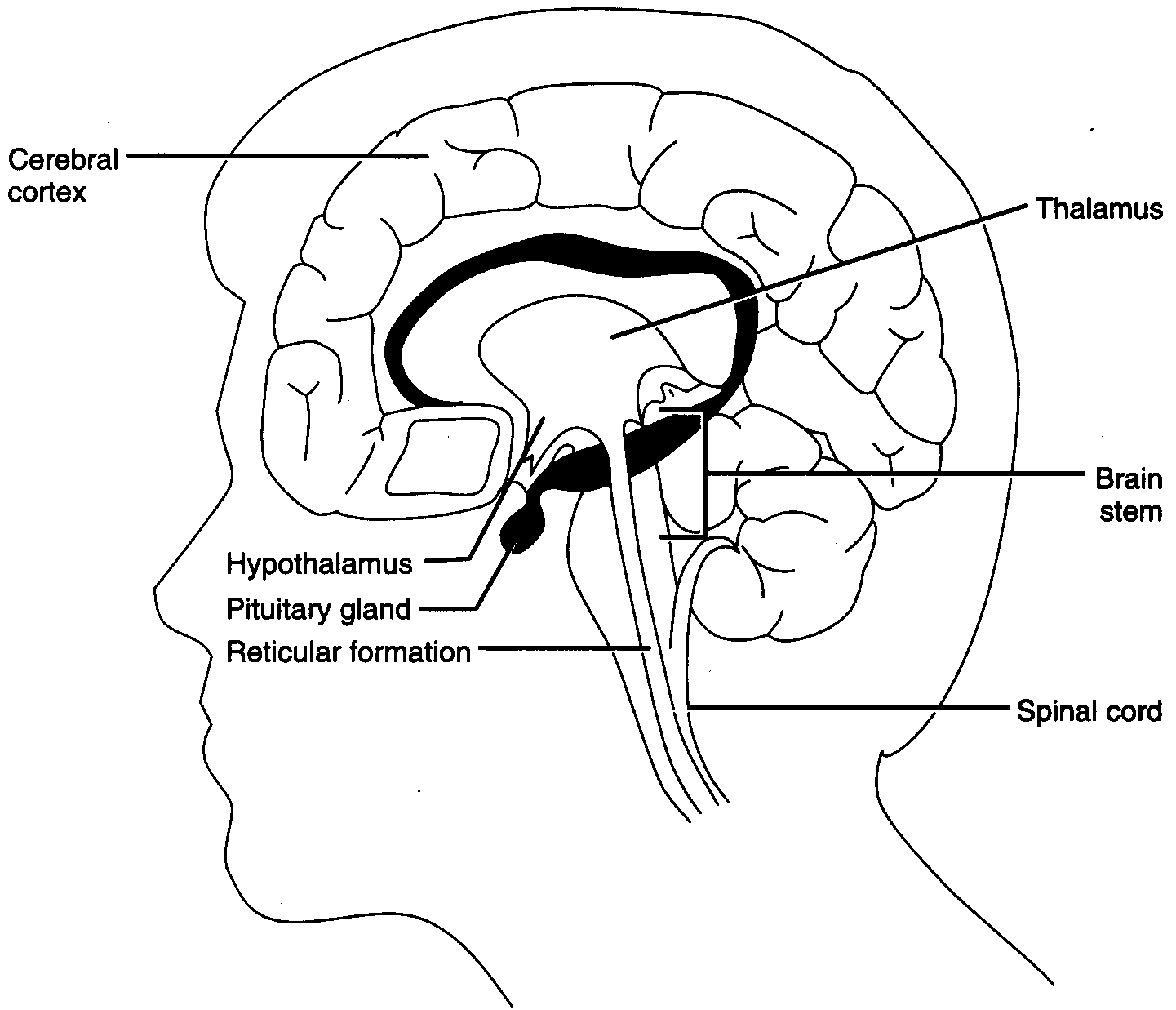
FIGURE
2.4 The Adrenal Glands
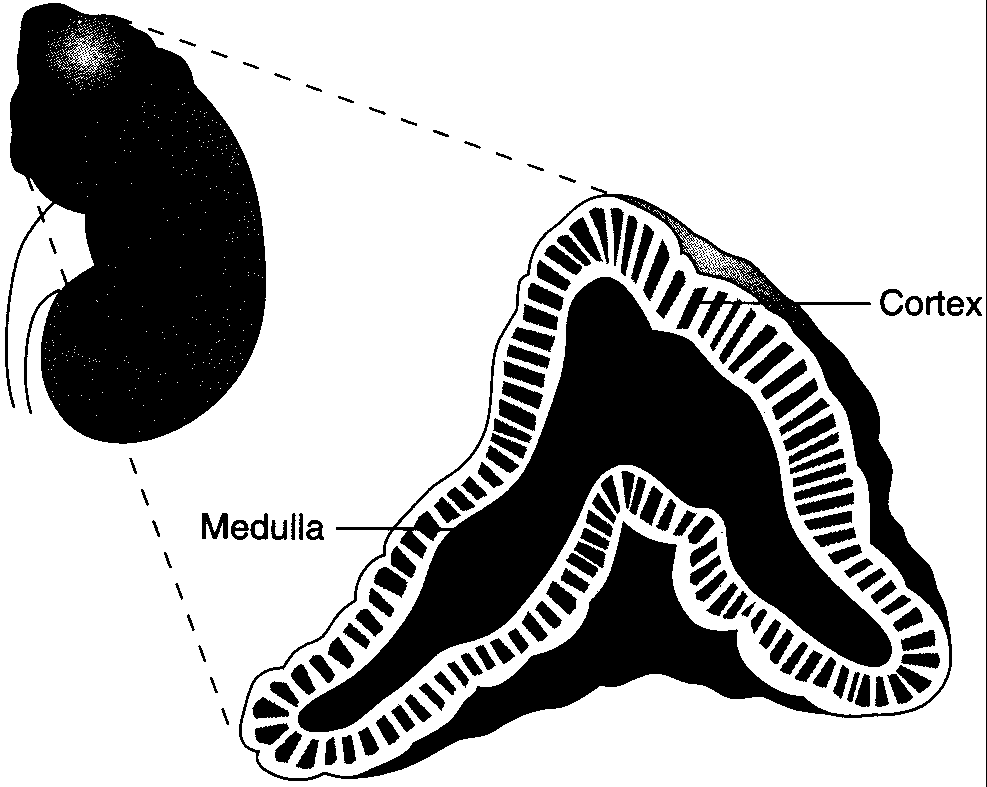
Stressed Out: Hormones of the Adrenal Cortex
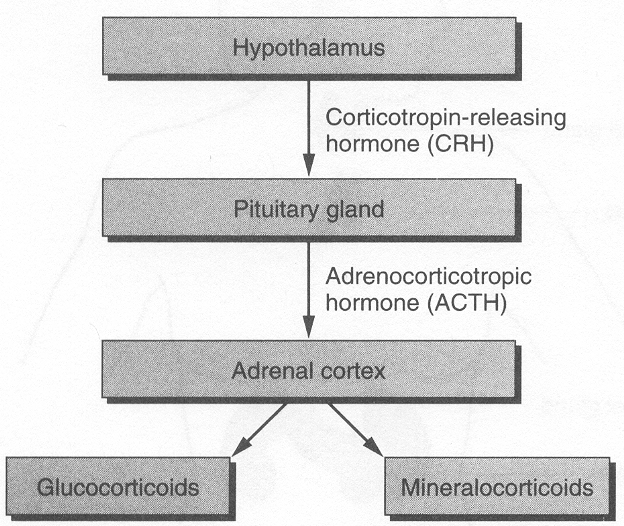
The adrenal cortex also secretes mineralocorticoids. Mineralocorticoids help control fluid
and salt balance. The mineralocorticoid alclosterone is responsible for about 95 percent of the
action of this hormone family. Aldosterone causes the kidneys to retain sodium and water, an
action that increases blood volume and consequently, blood pressure-both helpful if blood is
lost.
FIGURE 2.6
Glands that Participate in the Fight-or-Flight
Response
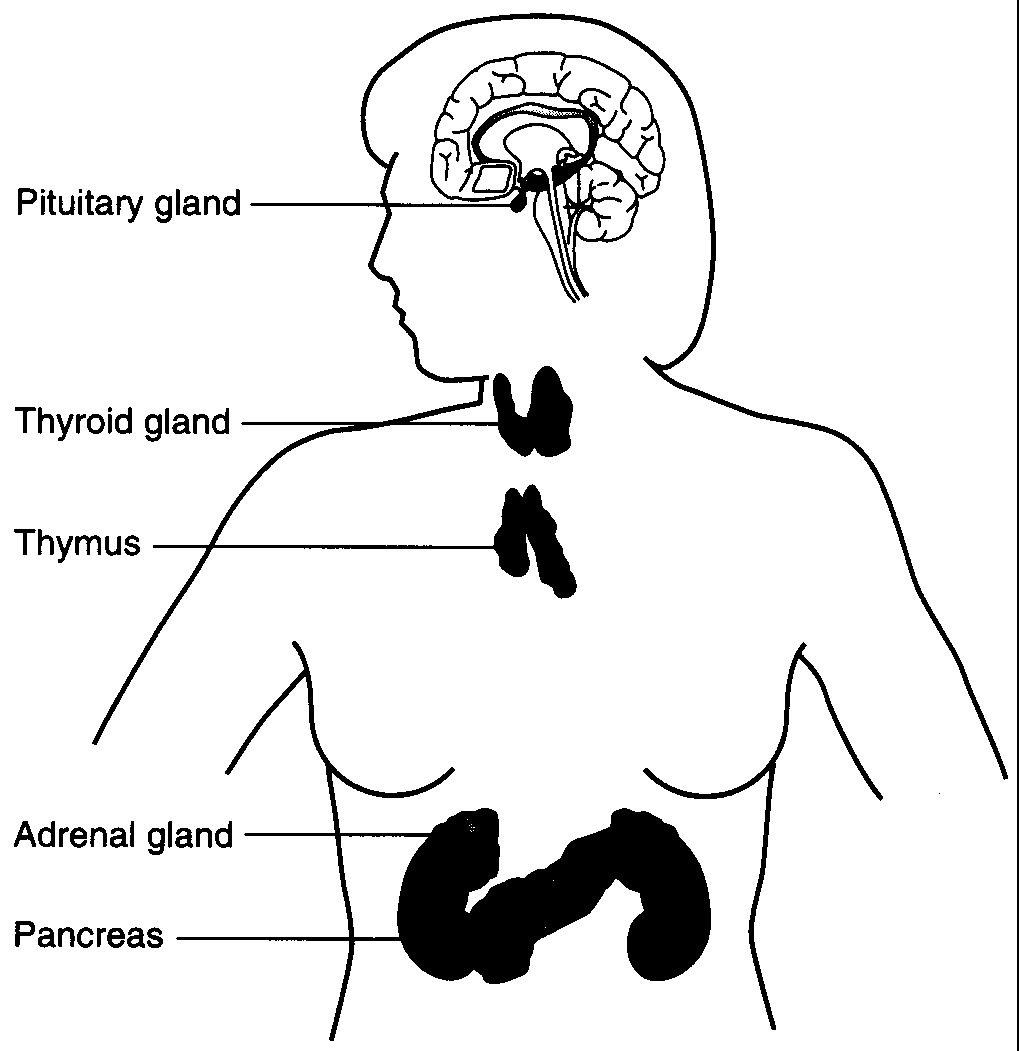

FIGURE 2.7 The Hypothalamus - Pituitary Thyroid
Pathway
FIGURE 2.8 Pathways of the major stress
hormones
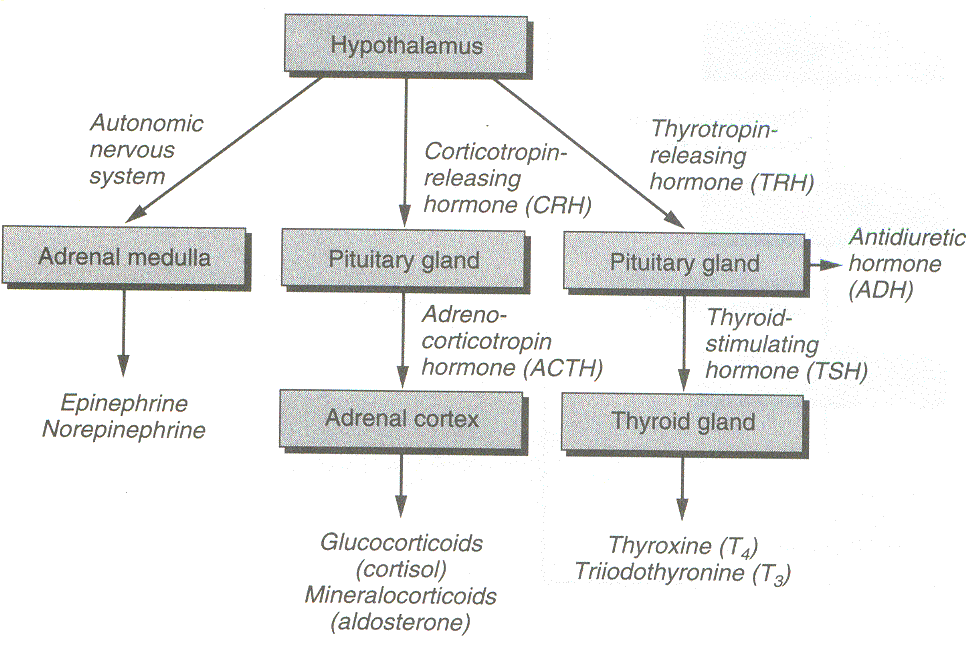
STRESS RESEARCH
STUDENT STRESS
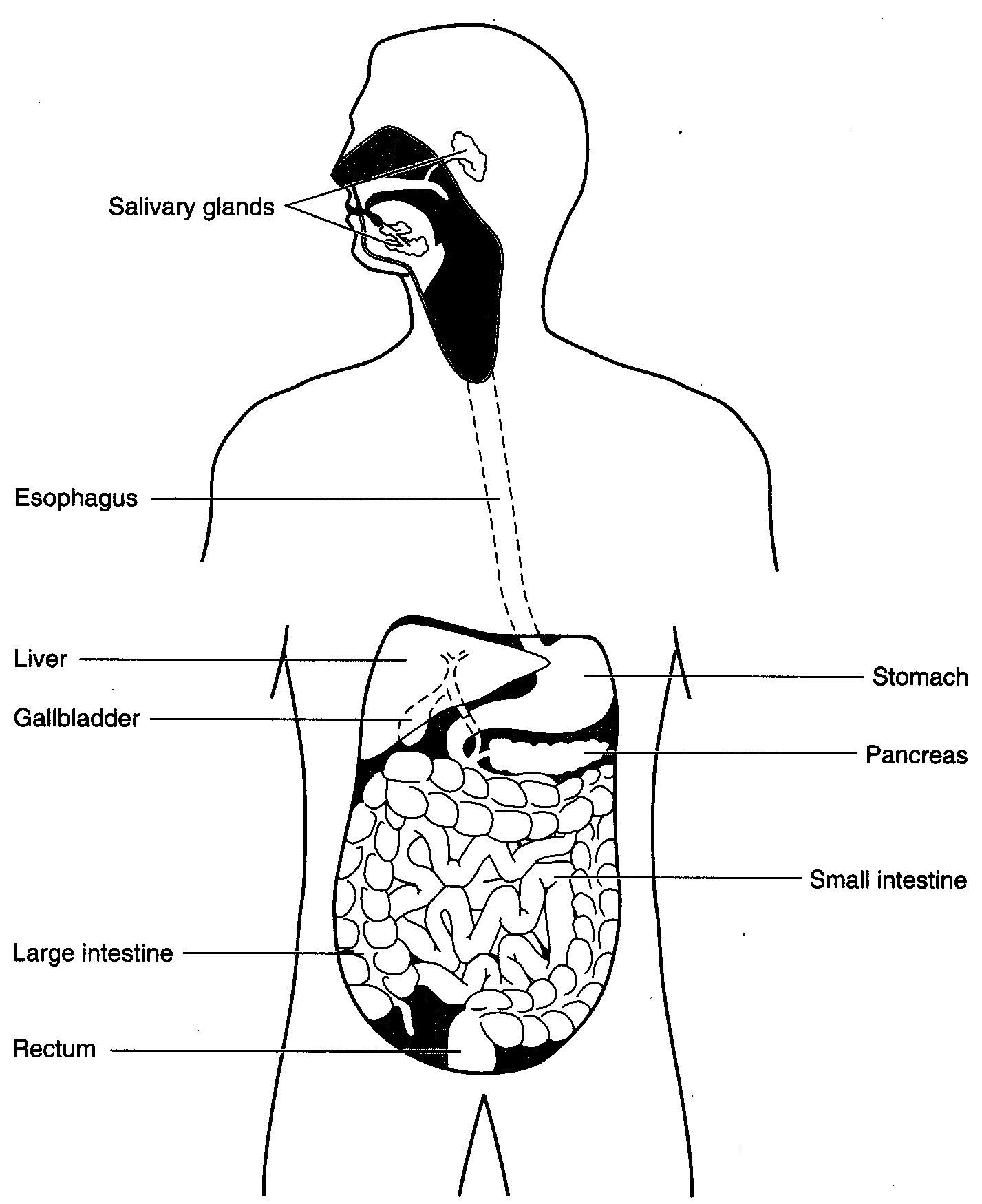
We've seen that as you run away from the snarling dog, digestion of your lunch
is put on hold as a strong cardiovascular response and contraction of skeletal muscles take priority. The normal flow of saliva decreases; stomach acidity may increase; peristaltic motion in the esophagus, stomach, and intestines may accelerate
or slow down. Noticeable symptoms include a dry mouth, stomach cramps or "butterflies,"
nausea, abdominal cramps, and even vomiting and diarrhea. These do not actually assist you as
you fight or flee but are side effects of the stress response and can be annoying. Chronic stress
can open a Pandora's box of digestive complaints from gum disease and esophageal spasms to
ulcers and constipation; they are discussed more fully in the next chapter.
STRESS AND YOU
REFERENCES